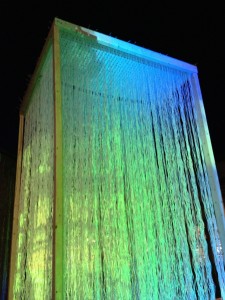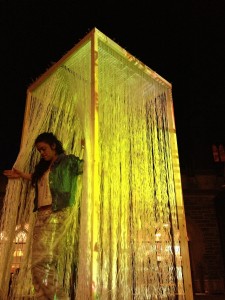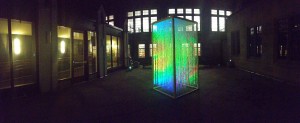Carlos Ignacio Hernández, VC 2013, presented his Urban Studies thesis in the Library’s courtyard this week. The Library was happy to provide Carlos with the space for his installation and event. Below is his description of his work.
My project is titled Pop-Up City(es). It is located in the Art Library Courtyard at Vassar College, a normally deserted space with no real sociability or programmatic qualities. With this in mind, this project aimed to occupy the space with a temporary structure that “pops up” and activates the precinct. A wooden frame made out of birch supports a perforated pegboard roof. Through the orifices of the board, synthetic string pieces make their way from top to bottom, conforming proportionally almost all of the structure’s negative space. On the sides of the structure, timelapse projections of four cities relevant to me and my life are shown. Caracas where I was born, Hong Kong where I went to high school, Copenhagen where I studied the sleek angles of Scandinavian architecture, and New York City, a metropolis in which I’ve spent a considerable amount of time and as a result of the lack of timelapse videos of Poughkeepsie that were available online.
Georg Simmel wrote on the urban experience and stated that the  “psychological foundation upon which the metropolitan individuality is erected is the intensification of emotional life due to the swift and continuous shift of external and internal stimuli.” (Simmel, Metropolis and Mental Life). I wanted to work with simulation of the idea of the city blasé attitude that fills our sidewalks and the replication of an urban journey that was overwhelming and over stimulating in visual terms.
“psychological foundation upon which the metropolitan individuality is erected is the intensification of emotional life due to the swift and continuous shift of external and internal stimuli.” (Simmel, Metropolis and Mental Life). I wanted to work with simulation of the idea of the city blasé attitude that fills our sidewalks and the replication of an urban journey that was overwhelming and over stimulating in visual terms.
The class session on Diller + Scofidio’s Blur Building was equally pivotal in the creative stages of this process. For the architects, when architecture is dematerialized and equated to the dubious, Blur becomes an experiment in the construction of de-emphasis and media becomes physically tangible. Pop-Up City(es) aims to contest the space-building process through barriers or walls. Instead, the switch in physicality between the “barrier” and the inside emphasizes the negative space inside the suprasensorial structure. Like the Blur Building, my installation is “a habitable medium” and is meant to generate a sense of curiosity in the spectator and invite her/him to explore and interact with the project in order act against the mobility of image/immobility of spectator dichotomy that Friedberg introduces in her book The Virtual Window.
Instead, the switch in physicality between the “barrier” and the inside emphasizes the negative space inside the suprasensorial structure. Like the Blur Building, my installation is “a habitable medium” and is meant to generate a sense of curiosity in the spectator and invite her/him to explore and interact with the project in order act against the mobility of image/immobility of spectator dichotomy that Friedberg introduces in her book The Virtual Window.
Brenner and Schmid’s Planetary Urbanisation manifesto brought ideas about international urban connections and transnationalism:
The creation of new scales of urbanization. Extensively urbanized interdependencies are being consolidated within extremely large, rapidly expanding, polynucleated metropolitan regions around the world to create sprawling “urban galaxies” that stretch beyond any single metropolitan region and often traverse multiple national boundaries.
Pop-Up City(es) is a city made out of cities. Through the timelapse projections of cityscapes around the world, this project aimed to comment on the global urban hierarchy and interdependence of cities around the planet, that grow as extensions of each other as a result of agglomerated urbanization. You can enter the structure on the Hong Kong side and exit through Caracas, or vice versa.
In Beatriz Colomina’s piece titled Enclosed by Images, the following introductory statement is made:
We are surrounded today, everywhere, all the time, by arrays of multiple, simultaneous images. The idea of a single image commanding our attention has faded away. It seems as if we need to be distracted in order to concentrate. As if we-all of us living in this new kind of space, the space of information–could be diagnosed en masse with Attention Deficit Disorder. The state of distraction in the metropolis, described so eloquently by Walter Benjamin early in the twentieth century, seems to have been replaced by a new form of distraction, which is to say a new form of attention. Rather than wandering cinematically through the city, we now look in one direction and see many juxtaposed moving images, more than we can possibly synthesize or reduce to a single impression.
The combination of elements of this piece (a frame filled with strings, projected images and interaction with the spectator) make it a combination of the ideas mentioned above, which Colomina carefully articulates so well.


Do you mind if I quote a couple of your posts as long as I provide credit and sources back to your blog? My blog site is in the exact same niche as yours and my visitors would definitely benefit from a lot of the information you present here. Please let me know if this okay with you. Thank you!
As long as you credit us and provide a link back, please feel free!
Thanks to Vassar Libraries for being part of the scholarly crossroads that students travel! Neat exhibition Carlos!